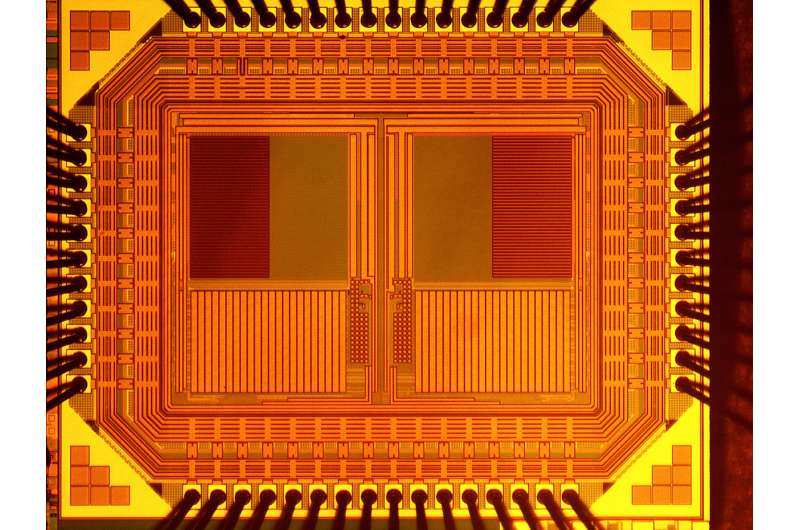April 10, 2018 weblog
This imaging sensor is powered by sunlight

A simultaneous imaging and energy harvesting sensor is in the news. Samuel Moore at IEEE Spectrum informed readers that a team of four from University of Michigan published their paper describing what they achieved. They built a prototype sensor, and what it does—-think of a future camera that just about watches you non-stop—is described in the journal, IEEE Electron Device Letters.
The article is titled "Simultaneous Imaging and Energy Harvesting in CMOS Image Sensor Pixels." The four authors are from University of Michigan: Sung-Yun Park, Kyuseok Lee, Hyunsoo Song and Euisik Yoon.
Their technology "puts the equivalent of a solar cell under each pixel," said IEEE Spectrum.
The potential is that tiny cameras, so tiny that they could sit almost anywhere, could work on and on. They are on to the makings of a self-powered camera. Ultimately, said Devin Coldewey in TechCrunch, "the sensor could be essentially a nearly invisible camera that operates forever with no need for a battery or even wireless power."
In a few sentences, IEEE Spectrum's Samuel Moore relayed what the university engineers achieved, in this twinned imaging and energy-harvesting sensor.
"Solar cells convert light to electricity. Image sensors also convert light to electricity. If you could do them both at the same time in the same chip, you'd have the makings of a self-powered camera." He said their image sensor can deliver 15 images per second "powered only by the daylight falling on it."
Moore said the 15 images per second happening would be on "a sunny, 60,000-lux day," enough to get the 15 frames per second— but figure 7.5 frames per second in normal daylight conditions (20,000-30,000 lux).
Coldewey in TechCrunch said, fully powered in sunlight, the captured images at up to 15 frames per second were of reasonable quality.
Moore reported that the resulting chip, "with its 5 micrometer-wide pixels, was capable of the highest power harvesting density (998 picowatts per lux per square millimeter) of any energy harvesting image sensor yet."
Nonetheless, the researchers at this stage, were only concerned with getting a proof-of-concept chip. They did not optimize the power consumption of the sensor itself, said Park, in the IEEE Spectrum report.
What is needed to reach a stage where it could be called something like a spy camera? Coldewey spelled out what it needs. He said requirements go beyond just an imaging component. He said "a storage and transmission medium are necessary for any camera to be useful. But microscopic versions of those are also in development, so putting them together is just a matter of time and effort."
Moore, meanwhile, reported that "If the project continues, they'll work to integrate everything needed for a self-powered wireless cameras."
This would not be the first time that Euisik Yoon and Sung-Yun Park have worked on image sensors. Moore said that Yoon and Park developed "ultralow power technologies for image sensors such as circuits that automatically adapt the frame rate to the available illumination and microwatt-scale feature detection systems."
More information: Sung-Yun Park et al. Simultaneous Imaging and Energy Harvesting in CMOS Image Sensor Pixels, IEEE Electron Device Letters (2018). DOI: 10.1109/LED.2018.2811342
Abstract
We present a prototype CMOS active pixel that is capable of simultaneous imaging and energy harvesting without introducing additional in-plane p-n junctions. The prototype pixel uses a vertical p+/nwell/psub junction that is available in standard CMOS processes. Unlike the conventional CMOS electron-based imaging pixels, where the nwell region is used as a sensing node for image capture, we adopted a hole-based imaging technique, while exploiting the nwell region for energy harvesting at a high fill-factor of >94%. To verify the feasibility, CMOS image sensors are fabricated and characterized. We successfully demonstrated that the energy harvesting can be achieved with a power density of 998 pW/klux/mm2, while capturing images at 74.67 pJ/pixel. The fabricated prototype device has achieved the highest power density among the recent state-of-the-art works and can self-sustain its image capturing operation at 15 fps without external power sources above ~60 klux of illumination.
© 2018 Tech Xplore





















